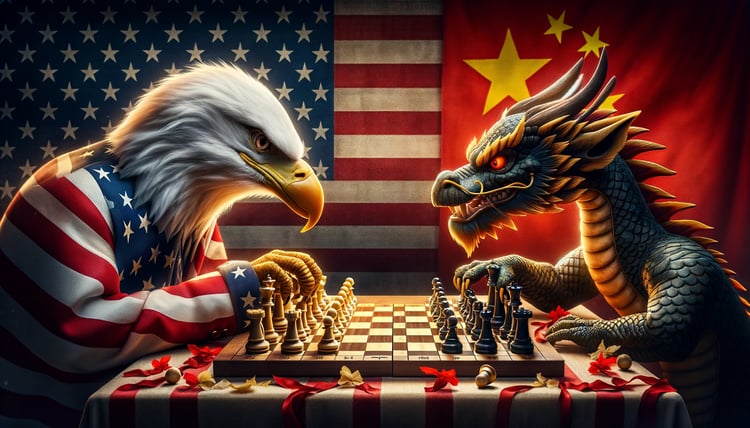China, Night Vision, and Our Self-Inflicted Wounds: The Strategic Mistake of Outsourcing Critical Technology

The Mistakes of Outsourcing to China
As a nation, we have a disturbing pattern. We develop new technology, follow the Jack Welsh model, and relentlessly pursue the lowest possible manufacturing cost, which typically means we outsource it to China. We transfer our intellectual property to an adversarial nation with limited respect for intellectual property laws, enabling them to compete in a new market. They then use their cost structure to subvert US-based manufacturing to the point we often lose the ability to manufacture that product domestically, and we create a self-imposed supply chain and disablement risk for our warfighters. We have seen this in dozens of industries, and we have seen China use this to influence US policy and create artificial supply change issues (think lithium for batteries).
Another Strategic Red Flag
In a recent revelation, the Association of U.S. Night Vision Manufacturers (ANVM) has flagged substantial incursions by Chinese night vision equipment manufacturers into the U.S. commercial market, threatening the technological edge of U.S. warfighters and potentially benefiting the Chinese People's Liberation Army (PLA). This infiltration manifests in three critical ways: aggressive financial subsidies by the Chinese government to its manufacturers, intellectual property theft of U.S. technologies, and the unintended assistance by U.S. consumers to refine these knock-off products, which could be fielded against U.S. forces in potential future conflicts.
The impact of these actions is far-reaching. The Chinese government’s support allows for undercutting prices on the global market, destabilizing fair competition. This practice has been well-documented, including in strategic analyses like those from Vermilion China. The consequence is that Chinese firms can offer night vision products at significantly lower prices, like a knock-off Binocular Night Vision Device (BNVD) sold for $5,200-$5,400 against the U.S. counterpart priced at $14,000 or a copied Ground Panoramic Night Vision Goggle (GPNVG) available for $22,000, almost half the price of the authentic $40,000 U.S. model.
The Recurring Risk
Beyond pricing, Chinese manufacturers have been blatantly infringing on U.S. intellectual property, with evidence of Chinese-made thermal imaging microbolometers infringing U.S. patents. Notably, such violations led to U.S. Customs and Border Protection interventions, as seen during a trade show in Las Vegas in January 2024.
Perhaps most insidiously, feedback from U.S. customers intended to help American companies refine their products is being funneled back to Chinese manufacturers. While innocent in intention, this feedback loop directly enhances the equipment capabilities that the PLA may use, thus inadvertently undermining U.S. military superiority.
The night vision market in the U.S. spans the military, law enforcement, and commercial sectors. While the military remains the ANVM's primary focus, the commercial sector—which serves civilians, hunters, and outdoor enthusiasts—is the most vulnerable to Chinese exploitation. With over half of the U.S. companies tied to Chinese products through resale or component sourcing, the problem is widespread.
Patching the Damage
The ANVM proposes decisive action to mitigate these risks, and Peak supports this corrective action. A suggested first step is the imposition of a 100% tariff on all night vision equipment imported from China, intending to neutralize the cost advantage currently exploited by Chinese firms. Such measures are imperative to safeguard U.S. interests and preserve the American principle of "owning the night" through technological superiority.
U.S. Policy Change Required
As the U.S. contends with this challenge, the broader implications for national security and the integrity of U.S. technological advances are clear. The ANVM stands firm in its commitment to support U.S. warfighters, advocating for a rapid and robust response to curtail Chinese advances into the U.S. market and, by extension, into the capabilities of their military forces. The unfolding scenario serves as a clarion call to U.S. policymakers and stakeholders to safeguard the nation's technological bastions and prevent adversaries from gaining an unintended upper hand.
It is a stark reminder that the interplay between commercial interests and national security can have profound implications, particularly in an era where technological overmatch is not just a strategic advantage but a necessity for occupational safety and success. As the U.S. seeks to address these self-inflicted wounds, the path forward will require a blend of strategic policy-making, enforcement of international trade laws, and increased awareness among U.S. consumers of the long-term implications of their purchases. Only through a concerted effort can the U.S. hope to maintain its hard-earned night vision supremacy and protect the warfighters who rely on this critical advantage.
Let’s Stop Doing This to Ourselves
However, the real solution is not to share this or other critical intellectual property with China. We need to make the strategic decision to reshore as we have done with the CHIPS act and to keep production of this and many other strategic technologies in the US and allied nations. It is often challenging to recognize missteps and even more difficult to change our actions personally, professionally, and nationally. This paper from the ANVM is a wake-up call for our industry and nation to stop creating self-inflicted wounds and giving our adversaries capabilities that put our warfighters at unnecessary risk.
